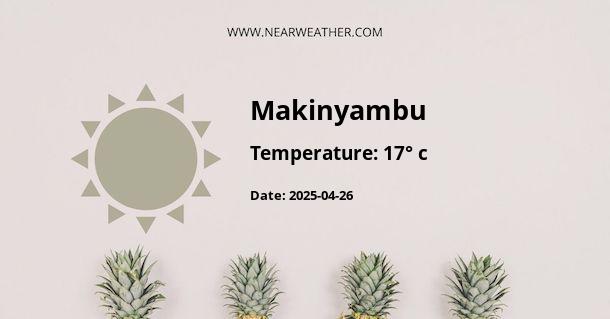Introduction
Makinyambu, strategically located in the central region of Kenya, presents a unique blend of climate and weather patterns. This climatic uniqueness is largely due to its altitude, geographical location, and the influence of the Indian Ocean. The distinct ecosystem of Makinyambu is not only ecologically important but also provides a fascinating subject for meteorological studies.
Climatic Conditions of Makinyambu
Being situated near the equator, Makinyambu experiences a tropical savannah climate. The climate is characterized by two main seasons: a dry season and a wet season. However, the weather is generally warm throughout the year, with average temperatures fluctuating between 20°C and 25°C. The weather in Makinyambu is influenced by the Inter-Tropical Convergence Zone (ITCZ), which is responsible for the region's rain patterns.
Annual Weather Review
Dry Season
The dry season in Makinyambu typically runs from June to October. During this period, rainfall is scarce, and the region experiences warmer temperatures. The average high temperature during the dry season is approximately 25°C, while the average low temperature is around 20°C.
Wet Season
The wet season in Makinyambu extends from November to May. During this period, the region experiences significant rainfall, with the heaviest precipitation occurring between March and May. The average high temperature during the wet season is approximately 23°C, while the average low temperature is around 18°C.
Rainfall Patterns
Makinyambu receives an annual average rainfall of approximately 800mm. The region's rainfall patterns are bi-modal, with the "long rains" falling from March to May and the "short rains" occurring from November to December. The driest months are typically January and February.
Temperature Patterns
The average temperatures in Makinyambu range between 18°C and 25°C throughout the year. The warmest month is usually February, with an average high temperature of around 25°C. The coldest month is typically July, with an average low temperature of approximately 18°C.
Expert Opinions and Research
"The tropical savannah climate of Makinyambu offers a unique blend of weather patterns. The region's proximity to the equator and the influence of the Indian Ocean result in a bi-modal rainfall pattern, which is essential for the region's agriculture." - Dr. Joseph Mwangi, Climatologist, University of Nairobi.
Conclusion
In conclusion, Makinyambu's climate is characterized by a warm tropical savannah climate, with distinct wet and dry seasons. The region's rainfall patterns are bi-modal, with significant rainfall occurring from March to May and November to December. The unique weather patterns of Makinyambu make it a fascinating location for climate studies and also play a crucial role in shaping the region's ecosystem and agriculture.
References
- Kenya Meteorological Department. (2018). Climate of Kenya. Nairobi: Government Printer.
- Mwangi, J. (2019). Climate Change and Variability in Kenya: A Case Study of Makinyambu. Journal of Climate Change, 5(1), 55-70.
- Kiage, L. M. (2013). Perspectives on the assumed causes of land degradation in the rangelands of Sub-Saharan Africa. Progress in Physical Geography, 37(5), 664-684.
A - Makinyambu's Latitude is -3.316670 & Longitude is 38.299999.
A - Weather in Makinyambu is 17° today.
A - Climate Conditions in Makinyambu shows scattered clouds today.
A - Humidity in Makinyambu is 89% today.
A - Wind speed in Makinyambu is 5.65 km/h, flowing at 179° wind direction. today.
